Assen 作者: 来源: 发布时间:2021-06-28
I.Population and Area
Coordinates: 53°0′N 6°34′ECoordinates: 53°0′N 6°34′E
Country Netherlands
Province Drenthe
Area
• Total 83.45 km2 (32.22 sq mi)
• Land 81.94 km2 (31.64 sq mi)
• Water 1.51 km2 (0.58 sq mi)
Elevation 10 m (30 ft)
Population (January 2019)
• Total 67,963
• Density 829/km2 (2,150/sq mi)
Demonyms Assenaar, Asser
Time zone UTC+1 (CET)
• Summer (DST) UTC+2 (CEST)
Postcode
9400–9409, 9486–9489, 9492
Area code 0592
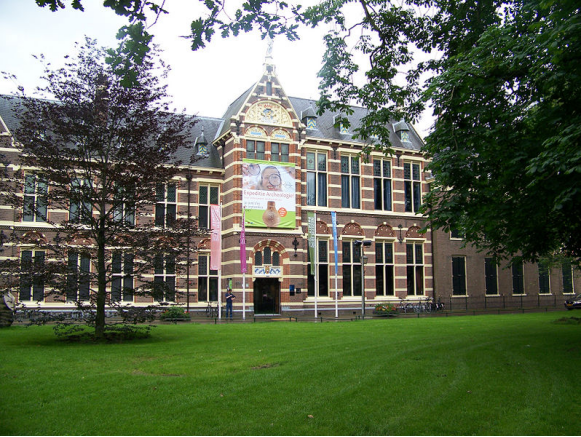
II.Natural Geography (environment and resources)
Assen railway station
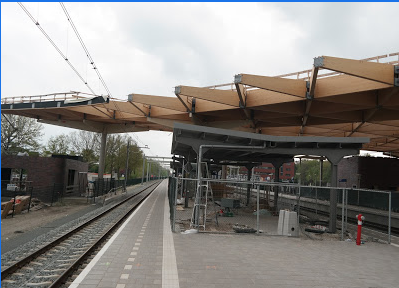
Address: 9401 KW Assen, Netherlands
Opened: May 1, 1870
Phone: +31 30 751 5155
Architect: Karel Hendrik van Brederode
Line(s) Meppel–Groningen railway
Connections
Bus transport VMNN: 1, 2, 3, 4 (shared with Qbuzz), 12, 53
Bus transport Qbuzz: 4 (shared with VMNN), 14, 15, 18, 19, 20, 21, 22, 24, 50, 58, 83, 110, 419, 603, 807
Assen is a railway station located in Assen, Netherlands. The station was opened on 1 May 1870 and is located on the Meppel–Groningen railway. The station is operated by Nederlandse Spoorwegen. A modern looking, new station building was built in 1988. From 1902 until 1947 there was also a railway line to Gasselternijveen, where trains connected to the railway line to Stadskanaal.
Future
The railway station and station area, is to be upgraded along with other public works around the city of Assen, such as the creation of a harbour quarter, joining up the canal system through the city and creation of a city boulevard. The road that passes outside the station will become an underground section. While above ground it will become pedestrianised towards the city centre and the new harbour quarter.
The upgraded station will accommodate an underground bicycle storage area, and cycle shop replacing the current outside stalls for rail users. The contract to re-design Assen station was won by the Powerhouse Company and De Zwarte Hond.
FlorijnAs is overseeing the wider works of improvement in the city and their website (which is available in Dutch and English) explains that: "Towards the end of 2015 the relocation of the cables and pipes for the station begins. Then the implementation of the road tunnel is planned for 2016, and In mid- 2016 ProRail is to start work with the tracks and the platform tunnel." However 27 August 2015 saw the website spoorPRO release an article, stating that the works on the tracks have been pushed back till 2017, due to "hard work being scheduled elsewhere on other projects in 2016", while further in the article ProRail and contractors are stated to have said they are "currently working on the biggest track renewal since the birth of the railways".
While there is expected to be disruption from these works for everyday users, the station is currently not due to close during the scheduled works.
There are plans to open a station south of this one, called Assen Zuid, which will serve southern Assen as well as the TT Circuit Assen.
How to get to Assen from 5 nearby airports
The nearest airport to Assen is Groningen (GRQ) Airport which is 14.2 km away. Other nearby airports include Amsterdam Schiphol (AMS) (143.4 km), Bremen (BRE) (148.8 km), Eindhoven (EIN) (188.8 km) and Dusseldorf (DUS) (191.5 km).
Reference: https://www.rome2rio.com/s/Nearby-Airports/Assen
Water and boating
Assen is accessible via Canals. Moring in Assen brings you in walking distance of our shopping centre, a variety of restaurants and terraces. Our sailing season starts on April 1st and ends on October 1st. Within this period you can sail and moor in Assen. Outside this period our bridges and sluices are only operated on special occasions.
III.Economy
Drenthe has a relatively low research and development (R&D) intensity compared to other Dutch provinces.
GDP per capita in purchasing power standard units was €26,300,
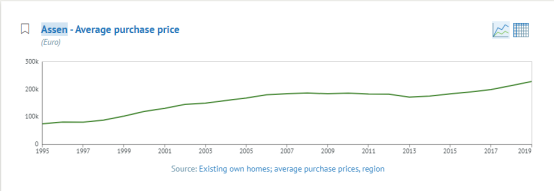
Total » Total » A-U All economic activities - Assen - Natural gas, delivered
23,219.00
1,000 m3 in 2018
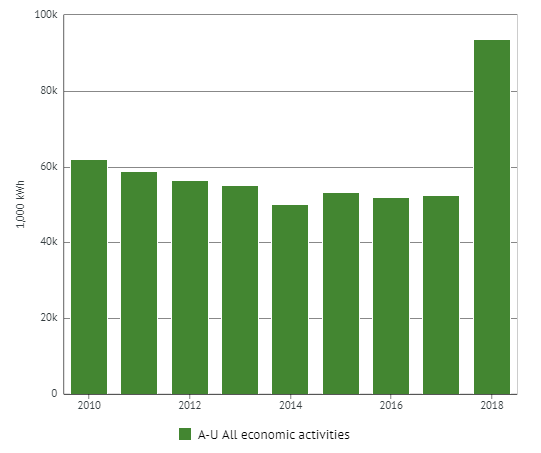
Reference: https://knoema.com/search?query=assen%20economy
IV.Industrial Characterisitics
NAM is an exploration and production company with authentic Dutch roots. Its headquarters are located in Assen in the Netherlands. NAM’s core business is exploring for and producing oil and gas, both onshore and offshore in the Netherlands.
NAM is responsible for unlocking two of the Netherlands’ most important resources: gas and oil. NAM supplies 75% of the natural gas required by Dutch households and businesses. 93% of all Dutch households use natural gas. Natural gas accounts for 45% of all the energy that is used in the Netherlands.
NAM, Source of our energy
As natural gas is an essential part of the energy mix and the energy transition at the same time, the Netherlands needs oil and gas, now and in the future. As largest gas producer in the Netherlands, NAM will play an important role in the energy transition.
Gas production
The Groningen gas field was discovered in 1959, and NAM has been producing Groningen natural gas since 1963. The Groningen field is one of the world’s largest gas fields (2,800 billion m³) and a significant volume of gas is still present in the field today. The Groningen gas field supplies gas to 98 percent of the population of the Netherlands. All domestic appliances are configured for this type of gas.
Production plan and programme of investigation
The Netherlands Ministry of Economic Affairs grantsgas production permit on the basis of the production plan. The production plan describes how NAM must produce gas in a safe and responsible manner.
Following the Huizinge earthquake on August 16, 2012, NAM submitted an amended production plan for the Groningen field at the end of 2013 in response to the Minister’s request. NAM also initiated an extensive programme of investigation in 2012. The programme has been budgeted at EUR 100 million. Approximately 25 universities and knowledge institutes around the world are involved in the programme.
Uncertainty remains regarding earthquakes and gas production from the Groningen field. The Minister therefore decided that the 2016 Production Plan should be updated again based on investigation results and new insights. NAM submitted an amended production plan on Friday 1 April 2016. Besides the production plan, NAM also submitted a “Measurement & Control Protocol” and a “Study and Data Acquisition Plan”.
Reference: https://www.nam.nl/english-information.html
V Tourism, culture and sport
Tourist Trophy
The TT Circuit Assen is one of the most famous motorcycle racing circuits in the world and is the only circuit that has been in the MotoGP calendar since its beginnings in 1949. It is also regarded as the "Cathedral of Motorcycle Racing."
Layout of the TT Circuit Assen
Capacity 110,000
FIA Grade 1
Owner Stichting Circuit van Drenthe
Opened 1955
Major events FIM MotoGP, Dutch TT, SBK, Champ Car World Series, Superleague Formula, British Superbike Championship, Motocross World Championship, DTM (2019), Supercar Challenge
Length 4.545 km (2.824 mi)
Turns 12 right, 6 left
Race lap record 1:18.298 (Ingo Gerstl, BOSS GP, 2018)
Website www.tt-assen.com
The TT Circuit Assen is a motorsport race track built in 1955 and located in Assen, Netherlands. Host of the Dutch TT, it is popularly referred to as "The Cathedral" of motorcycling by the fans of the sport. The venue holds the record for being the only circuit to have hosted a Grand Prix motorcycle event every year since the series was created in 1949. It has a capacity of 110,000 spectators, including 60,000 seats. Since 1992, the circuit has also been part of the Superbike World Championship calendar.
Drents Museum
The Drents Museum provides a view of the world and of Drenthe, with stories about archaeology, art and history.
The Yde Girl
Before her execution, one half of this girl's head was shaved. She was only sixteen, about 140 cm tall and she had blond hair. Around the beginning of the Common Era, this adolescent was strangled with a woolen band which the executioner had wrapped around her neck three times. Possibly, she was also stabbed in the neck near the left collarbone. She rested in the peat bog near the village of Yde for almost two thousand years, until two workers discovered her in May 1897 - and then ran away in fright. Days later most of her body parts and fragments of a cloak were dredged up from the peat. Unfortunately, the villagers had also heard about this find. They had secretly removed nearly all her teeth and tore off most of her hair.
Dance
In November of each year Assen becomes the centre of international attention for the world of Ballroom and Latin American dancers when the city hosts the Assen Dance Festival which includes the Dutch Open Championships. This is an open event for dancers from all countries.
Cycling
Assen is also the capital of the "cycling province" of the Netherlands, Drenthe. There are many high quality cycle paths in the city and surroundings and it is host to regular cycling events such as the Drentse fietsvierdaagse and the Jeugdtour. In 2009 the prologue and opening stage of the Vuelta a España took place in Assen.
The city has twice hosted the International Six Days Enduro.
Association football
Asser Christelijke Voetbalvereniging was founded in 1939 and is one of the most successful amateur clubs in Dutch football.
VI History
The history of the capital of Drenthe can be traced back to at least 1258, when a new location had to be found for Marienkamp Abbey, which had originally been built near Coevorden as a penalty for the slaughter in 1227 of the army of the Bishop of Utrecht at the hands of Drenthe's peasants, in what has come to be known as the Battle of Ane – a battle, incidentally, in which the bishop was killed. His successor ordered the nunnery to be built as a penalty. As it was located in a barren peat area, which also happened to flood from time to time, a better location had to be found. A better and especially drier spot for the Cistercian abbey was found in an area known as Witten, where at the time only a few farms were located. Around it were village communities like Deurze, Witten and Peelo. The latter has a history which goes back to the times from when Dolmens were built, but it is now situated between two new districts of Assen. The "relocated" abbey probably was erected in the 1260s, and over the centuries Assen developed around it.
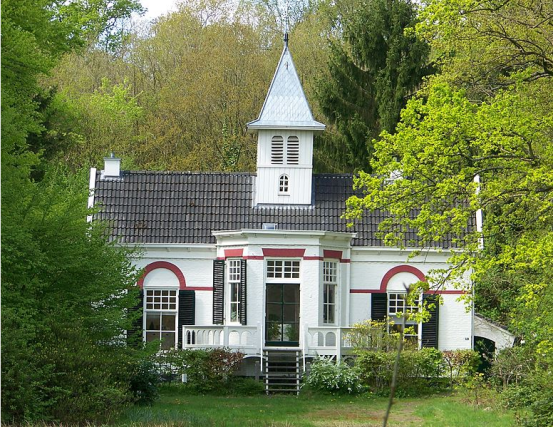
Typical monumental building in Assen park "De Eerste Steen", a former estate.
Abbey
The abbey was built at what now is the Brink (i.e., the grassy area which serves as a symbolic municipal centre) of Assen. On the abbey site now stands the Drents Museum, which was built in 1882 as provinciehuis (i.e., the residence of provincial government). Only the abdijkerk (abbey church), the grounds, and bits and pieces of walls remind us of the religious beginnings of the city.
Coat of arms
The coat of arms is directly borrowed from the seal of the abbey. It is just like the coat of arms of the province of Drenthe - in both cases Mary with child - but Jesus switches to the other knee. The history of the city is connected with the provincial governing board: around 1600 the abbey property was secularised. Marienkamp no longer existed, but the buildings did. Because of the central position of Assen and the fact that the government from what was then called de Landschap Drenthe (the Landscape Drenthe) was searching for a location for the government and civil servants, Assen became the seat for, and thus practically also the capital of Drenthe.
Drents Haagje
Assen was not a municipality yet, not even ecclesiastical sense. Even though there was an abbey church, Assen fell ecclesiastically and administratively under Rolde. In 1615 Assen got its own preacher. In 1807 Assen administratively freed itself from the control of Rolde when the village got to establish its own municipal authorities. A municipal authority which moreover in most cases operated in the shadow of the provincial government, which always manifested itself prominent in the Drentse Haagje. The municipal authority mainly got there because of matter of provincial governors like Governor Petrus Hofstede, to which the city also thanks its uniquely located park (in the center of the city). From that time Assen also obtained its nickname het Herenbolwerk.
City rights
Assen has been an official city since 1809. After Coevorden, then a village of about sixteen hundred people, Assen became the second place in Drenthe with city rights, granted by King Louis Napoleon, who had big plans for the village. A plan to make it a city was set up at the time, but the Kingdom of the Netherlands was incorporated into Napoleon Bonaparte's French Empire and the plans were abandoned.
As an administrative centre, Assen attracted well-to-do inhabitants and with that also new enterprises and initiatives. These contributed to a slow but steady increase of commerce, wealth and new establishments; such a newspaper in 1823, a Latin school in 1825, a postal service on Groningen in 1830, a court in 1840, a first beginning for a garrison in 1852 and a railway station in 1870. Another major achievement was the canal Drentse Hoofdvaart, which was used for transporting peat and other goods; the canal Noord-Willemskanaal was opened in 1861. The most important monuments of the city are from the nineteenth century.
Industry
Around 1900 Assen began to play a more prominent industrial role. It was originally a centre of civil servants, but the establishment of a slaughterhouse, dairy factory and iron foundry created more diverse expansion opportunities and encouraged growth. Around 1930, by establishing various psychiatric hospitals and healthcare centres, Assen became a central point for health care in the province.
Growth
After the Second World War, Assen did not have more than 20,000 inhabitants. The Assen TT made the city more widely known, but it was not until the 1950s, with the development of an industrial core, did Assen begin to grow more quickly. The Nederlandse Aardolie Maatschappij (Dutch Oil Company) established itself in the city and with that, a trend was set. Now, Assen is known not only because of its TT, Bartje and the Drentse Rijwielvierdaagse. It also is the fastest-growing city in the northern part of the Netherlands, with ample employment opportunities, particularly in the service industry. An unprecedented growth of the city in terms of houses and inhabitants is taking place with environmental issues becoming more urgent.
The Assen railway station connects the city to the rest of the country. Assen's city centre is closed to through motor traffic (except emergency vehicles), it has an extensive network of off-road cycle paths, and 41% of all journeys in Assen are by bicycle. The city has progressively become more cycle friendly since the 1960s.
VII.Other information
Host of the Dutch TT, it is popularly referred to as "The Cathedral" of motorcycling by the fans of the sport. The venue holds the record for being the only circuit to have hosted a Grand Prix motorcycle event every year since the series was created in 1949.
VIII.Contact information
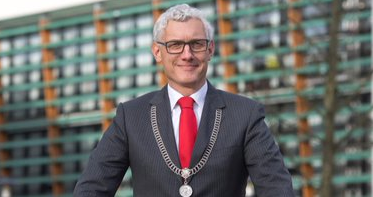
Mayor Marco Out
Born: June 26, 1970 (age 50 years), Maarsbergen, Netherlands
Twitter: Marco Out @MarcoOut
Contact
Phone: (+31)(0)592 366166
WhatsApp: +31610329433
E-mail: info@assen.nl
Address: Noordersingel 33, 9401 JW Assen
https://english.assen.nl/
Facebook: Municipality of Assen @CityofAssen
Twitter: Gemeente Assen @Gemeente_Assen
